求助PDF
{"title":"高度近视黄斑孔脱离玻璃体切除术后的解剖和功能结果。","authors":"Na Yang, Xiaoying Wen, Yueling Zhang","doi":"10.1177/11206721251372399","DOIUrl":null,"url":null,"abstract":"<p><p>PurposeTo assess structural and functional retinal recovery after vitrectomy for macular hole retinal detachment (MHRD) in high myopia using optical coherence tomography (OCT), OCT angiography (OCTA), and multifocal electroretinography (mfERG), focusing on reattachment rates, macular hole closure patterns, visual outcomes, and correlations between imaging and functional metrics.MethodsA retrospective study of 45 eyes with high myopia (axial length ≥26.0 mm) undergoing vitrectomy with internal limiting membrane peeling and silicone oil tamponade. Preoperative and postoperative evaluations at 1 week, 1, 3, 6, and 12 months included best-corrected visual acuity (BCVA, logMAR), OCT, OCTA (superficial capillary plexus vessel density, SCPVD), and mfERG (central retinal N1/P1 amplitudes). Statistical analyses compared longitudinal outcomes.ResultsRetinal reattachment achieved 95.56% (43/45 eyes). Macular closure rates: U-type (normal foveal contour, 71.74%), V-type (steep foveal contour, 4.35%), W-type (flattened hole margins without neurosensory retina restoration, 23.91%). BCVA improved significantly from 1.33 ± 0.36 (baseline) to 0.88 ± 0.08 logMAR (<i>P</i> < 0.01). OCTA showed increased SCPVD in parafoveal regions (rings 2-3, <i>P</i> < 0.05). mfERG revealed progressive N1/P1 amplitude recovery (<i>P</i> < 0.01), with stable latencies.ConclusionVitrectomy achieved high anatomical success and functional recovery in MHRD, with structural improvements preceding functional gains. OCTA and mfERG provided complementary insights into vascular and electrophysiological restoration. Persistent W-type closures highlight challenges in complex cases, underscoring the need for refined surgical strategies. Multimodal assessments are critical for monitoring postoperative recovery.</p>","PeriodicalId":12000,"journal":{"name":"European Journal of Ophthalmology","volume":" ","pages":"11206721251372399"},"PeriodicalIF":1.4000,"publicationDate":"2025-09-15","publicationTypes":"Journal Article","fieldsOfStudy":null,"isOpenAccess":false,"openAccessPdf":"","citationCount":"0","resultStr":"{\"title\":\"Anatomical and functional outcome after vitrectomy for macular hole detachment in high myopia.\",\"authors\":\"Na Yang, Xiaoying Wen, Yueling Zhang\",\"doi\":\"10.1177/11206721251372399\",\"DOIUrl\":null,\"url\":null,\"abstract\":\"<p><p>PurposeTo assess structural and functional retinal recovery after vitrectomy for macular hole retinal detachment (MHRD) in high myopia using optical coherence tomography (OCT), OCT angiography (OCTA), and multifocal electroretinography (mfERG), focusing on reattachment rates, macular hole closure patterns, visual outcomes, and correlations between imaging and functional metrics.MethodsA retrospective study of 45 eyes with high myopia (axial length ≥26.0 mm) undergoing vitrectomy with internal limiting membrane peeling and silicone oil tamponade. Preoperative and postoperative evaluations at 1 week, 1, 3, 6, and 12 months included best-corrected visual acuity (BCVA, logMAR), OCT, OCTA (superficial capillary plexus vessel density, SCPVD), and mfERG (central retinal N1/P1 amplitudes). Statistical analyses compared longitudinal outcomes.ResultsRetinal reattachment achieved 95.56% (43/45 eyes). Macular closure rates: U-type (normal foveal contour, 71.74%), V-type (steep foveal contour, 4.35%), W-type (flattened hole margins without neurosensory retina restoration, 23.91%). BCVA improved significantly from 1.33 ± 0.36 (baseline) to 0.88 ± 0.08 logMAR (<i>P</i> < 0.01). OCTA showed increased SCPVD in parafoveal regions (rings 2-3, <i>P</i> < 0.05). mfERG revealed progressive N1/P1 amplitude recovery (<i>P</i> < 0.01), with stable latencies.ConclusionVitrectomy achieved high anatomical success and functional recovery in MHRD, with structural improvements preceding functional gains. OCTA and mfERG provided complementary insights into vascular and electrophysiological restoration. Persistent W-type closures highlight challenges in complex cases, underscoring the need for refined surgical strategies. Multimodal assessments are critical for monitoring postoperative recovery.</p>\",\"PeriodicalId\":12000,\"journal\":{\"name\":\"European Journal of Ophthalmology\",\"volume\":\" \",\"pages\":\"11206721251372399\"},\"PeriodicalIF\":1.4000,\"publicationDate\":\"2025-09-15\",\"publicationTypes\":\"Journal Article\",\"fieldsOfStudy\":null,\"isOpenAccess\":false,\"openAccessPdf\":\"\",\"citationCount\":\"0\",\"resultStr\":null,\"platform\":\"Semanticscholar\",\"paperid\":null,\"PeriodicalName\":\"European Journal of Ophthalmology\",\"FirstCategoryId\":\"3\",\"ListUrlMain\":\"https://doi.org/10.1177/11206721251372399\",\"RegionNum\":4,\"RegionCategory\":\"医学\",\"ArticlePicture\":[],\"TitleCN\":null,\"AbstractTextCN\":null,\"PMCID\":null,\"EPubDate\":\"\",\"PubModel\":\"\",\"JCR\":\"Q3\",\"JCRName\":\"OPHTHALMOLOGY\",\"Score\":null,\"Total\":0}","platform":"Semanticscholar","paperid":null,"PeriodicalName":"European Journal of Ophthalmology","FirstCategoryId":"3","ListUrlMain":"https://doi.org/10.1177/11206721251372399","RegionNum":4,"RegionCategory":"医学","ArticlePicture":[],"TitleCN":null,"AbstractTextCN":null,"PMCID":null,"EPubDate":"","PubModel":"","JCR":"Q3","JCRName":"OPHTHALMOLOGY","Score":null,"Total":0}
引用次数: 0
引用
批量引用

 求助内容:
求助内容: 应助结果提醒方式:
应助结果提醒方式:


